The essence of technology
The principle of action of acid peeling is to provoke a chemical burn of the skin, in response to which restoration processes are launched in the skin. The procedure helps achieve skin rejuvenation and eliminate a number of problems. After peeling, active cell division occurs in the skin, renewal of the epidermis is accelerated, which leads to an improvement in the appearance of the skin. In addition, acids cleanse the ducts of the sebaceous glands, reduce excess oil, stimulate skin fibroblasts, which leads to increased collagen synthesis.
Ufology
The sun is a no-no for fruit exfoliation. Many factors influence sun resistance. Therefore, the doctor must definitely clarify whether you are taking retinoids or birth control pills. And if it’s summer or winter, you’ll have to wait until the elements calm down to the Central European serenity of at least +1ºС, otherwise cracks or hyperpigmentation may appear on your face after the procedure.
Acid peels at home can be divided into 3 groups:
- Compositions prescribed by the doctor in preparation for the peeling course;
- Recipes from natural ingredients;
- Professional products for home use (alternative to salon products).
Types of acid peels
There are 3 types of chemical peeling based on the depth of cleaning:
- Surface. It affects only the upper stratum corneum of the epidermis.
- Average. Affects the middle layers of the epidermis.
- Deep. Affects all layers of the epidermis, including the papillary layer.
Superficial peeling is considered the most popular, since complications rarely arise after it and there is no need to sit at home for 7-14 days waiting for redness, swelling or severe peeling to go away.
The main types of acid peeling include:
- Glycolic. Effective for problematic and aging skin. Glycolic acid acts on the upper layer of the dermis, burning old cells and, in contact with new ones, speeds up the metabolic process. Glycolic peeling is used for hyperkeratosis, acne, seborrhea, age-related skin changes, and age spots. The recommended course is 4-6 procedures.
- Salicylic. It has proven itself in the fight against acne, enlarged pores and oily skin. This peeling is carried out for folliculitis, hyperkeratosis, photoaging and oily seborrhea. The recommended course is 4-6 procedures with an interval of 7-10 days.
- Lactic. Suitable for sensitive and thin skin. Light superficial peeling that helps cope with acne, age spots, seborrhea, hyperkeratosis, enlarged pores, sagging skin and fine wrinkles. It has a strong moisturizing effect
- Almond. Suitable for problematic and oily skin. Used to eliminate post-acne, scars and age spots. After the procedure, the skin becomes more hydrated, the complexion is evened out, and skin regeneration occurs.
- Trichloroacetic. TCA peeling effectively combats flat birthmarks, skin unevenness, fine wrinkles, enlarged pores, solar lentigo, signs of photoaging and hyperkeratosis.
- Fruit. During the procedure, citric and malic acids are used. They cleanse the skin of dead cells, leaving it fresh and radiant. Fruit peeling stimulates cell self-healing, as a result of which they intensively produce elastin and collagen.
When choosing a peel, the cosmetologist takes into account the patient’s age, skin condition and problems that need to be worked on.
Main mechanism of action
Understanding the basic anatomy and structure of the skin, which consists of:
- epidermis - the upper thin layer in which metabolic and metabolic processes occur with the reproduction of epithelial cells necessary to protect the body from the penetration of harmful bacteria and microbes;
- dermis, which includes 2 balls (papillary and reticular), where elastin and collagen fibers are located, maintaining the elasticity of the epidermis. The dermis contains blood vessels and nerve endings;
- hypodermis or subcutaneous fat, between the fibers of which there are fat cells (lipocytes). Its purpose is to protect the body from environmental temperature fluctuations.
Acid peeling can be:
- superficial - partially or completely removing the epidermis layer. It is performed using fruit, glycolic, lactic or salicylic acid;
- median - affecting the epidermis and dermal layer, due to which a pronounced rejuvenating effect occurs after regeneration. This procedure involves the use of retinoic or trichloroacetic acid;
- deep - related to surgical operations and performed only in medical institutions. This type of peeling eliminates not only wrinkles, but also scars that occur after severe forms of acne and acne. During the manipulation, an active substance called phenol is used, which reaches the hypodermis, and in some cases affects the basement membrane.
By choosing a certain type of acid, a cosmetologist acts on the desired layer of skin that has defects or needs correction. As a result, a burn occurs, which activates the process of tissue regeneration with active division and growth of new cells of the skin structure.
The stronger the skin burn, the more intense the recovery and renewal processes will occur in it!
In what cases do peelings give the best results?
Acid peeling gives the best results if you have the following problems:
- acne;
- black dots;
- post-acne;
- hyperpigmentation;
- scars;
- papillomas;
- enlarged pores;
- keratomas;
- flabbiness;
- fine wrinkles;
- excessive dry skin.
After chemical peeling, it is allowed to carry out mesotherapy, plasma lifting, contouring, biorevitalization, and botulinum therapy.
Side effects and complications
Predictable.
- Erythema is redness of the skin, which depends on the concentration of substances and lasts up to 2-3 hours with superficial peeling, up to 5 days with medium peeling, and up to 2 months with deep peeling.
- Exfoliation is the removal of a thin layer of dead cells. It can be small-plate for superficial peeling and large-plate for medium peeling. Duration varies from 3 to 7 days.
- Swelling after chemical peeling is a natural reaction to a violation of the integrity of the skin and an increase in capillary permeability during medium and deep peelings. Stores for 2 to 4 days.
- Changes in skin color (darkening) are response mechanisms due to peeling, which lasts up to 14 days.
- Sensitivity is a manifestation of skin reflexes to the penetration of products, which persists for 14 days.
Undesirable (as a result of improper post-procedure care, individual characteristics or after poor-quality implementation of the technique). They are divided into immediate (up to 2 weeks after the procedure) and delayed (from 3 to 10 weeks).
- Exacerbation of acne is an inflammatory reaction characteristic of oily skin. Antibiotics are prescribed to suppress the processes.
- Activation of herpetic infection - occurs in the absence of a preventive course before peelings. If a rash occurs, antiviral medications are recommended.
- The addition of a secondary infection is manifested by pustular rashes due to non-compliance with antiseptic rules and a proper recovery period. Local or systemic antibacterial agents are used.
- Allergic reaction - to prevent the appearance of rashes, a test test is first carried out on a limited area of the skin to identify possible manifestations. When they occur, antihistamines (for example, Erius) are used.
- Persistent redness of the skin - occurs when blood vessels are dilated after deep peeling. In this case, it is important to follow the necessary recommendations after the sessions.
- Hyperpigmentation is the activation of cells that produce pigment (melanin). In this case, pre-peel preparation and the use of retinoic and phenol peels are important, as well as mesotherapy to reduce age spots.
- The demarcation line is a clear boundary between the treated and undamaged areas of the skin. Leveled by Jessner peeling.
- Scars (hypertrophic, keloid) - appear with medium and deep chemical peels. Corrected by laser exposure, ozone therapy, electrophoresis with lidase.
How is peeling done?
Preparation. Before the procedure, you need to use special products selected by a cosmetologist. This is necessary in order to prepare the skin for more effective exposure to acids. It is recommended to start preparing 7-14 days before peeling.
Carrying out the procedure. First, the cosmetologist cleanses the skin of street dirt and makeup. Then he applies the solution to the face in a certain sequence and monitors the skin’s reaction. The mixture is kept for some time (depending on the type of peeling), after which a post-peel preparation is applied to the skin to neutralize the acid and moisturize the skin. At the final stage, the doctor treats the skin with a special composition that accelerates cell regeneration.
Recovery period. After the procedure, it is recommended not to touch the skin or apply cosmetics during the day.
It is necessary to refrain from visiting a solarium and prolonged exposure to direct sunlight. For washing, you need to use professional gels that contain reducing acids. The cosmetologist will also recommend creams and gels of light texture with a moisturizing effect. To speed up the recovery process, you should use nourishing antiseptics with a regenerating effect. You need to include foods containing vitamins, proteins, and antioxidants in your diet.
Procedure technology
This technique requires special attention, accuracy, compliance with the optimal concentration of acids, as well as the duration of their effect on the skin structure, in order to avoid undesirable consequences and serious complications. The sequence of manipulation consists of the following steps:
- The first, which consists of mandatory cleansing of the skin surface from makeup and degreasing it.
- The second, which involves the application of a peeling composition, when a selected type of acid (or a mixture of different acids) is applied in a thin layer to the clean epidermis and left for the required period of time. During this action, the patient may feel a burning sensation or slight tingling sensation on the skin, indicating the need for careful monitoring by a cosmetologist. If unexpected reactions occur on the client’s skin, or the acid’s time has expired, proceed to the next stage.
- The third step is to neutralize the applied composition by applying a special solution, the effect of which is aimed, among other things, at moisturizing and toning the epidermis after the session.
- The final 4th stage consists of applying a special cream to the skin surface, which has a stimulating effect on the process of cell regeneration.
After receiving an acid burn, the epidermis needs special care, which includes following all the instructions of the cosmetologist who performed the manipulation!
Contraindications
All acid peels have the following contraindications:
- herpetic infection;
- pustular rashes;
- viral warts;
- aggravated acne;
- psoriasis;
- eczema;
- skin wounds;
- individual intolerance to acids;
- oncology;
- renal or liver failure;
- disturbances in the functioning of the cardiovascular system.
Temporary contraindications include facial hair removal, which should be performed at least 1 week before chemical peeling. It is also prohibited to perform mechanical and laser dermabrasion at least 6 months before the procedure.
Acid peels are contraindicated in cases of severe rosacea. At the initial stage of the appearance of the vascular network, it is allowed to carry out gentle superficial peelings with acids with a minimum concentration.
The possibility of carrying out the procedure for pregnant and lactating women is agreed with the doctor. In the absence of contraindications, gentle superficial peeling is permitted.
Chemical peeling should be used with caution if you have tattooed lips and eyes, since exposure to aggressive acids may change the pattern.
MULTIFRUIT GARDEN
Now let's understand the terminology. The exfoliating composition may contain more than one acid, and then we are talking about multi-acid peeling . It is not as strong in its effects as, for example, pure glycolic (a champion in tissue penetration due to its low molecular weight), but it is certainly better in other respects.
We recommend: ASPIRIN PEELING AT HOME (Recipe from model Shelley Barrett)
Thus, in combination with vitamins A and E, glycolic acid has a more pronounced antioxidant effect, and in alliance with seaweed, natural oils and a high UV factor, it is more suitable for the rehabilitation period.
Myths about acid peels
Myth 1. Acid peeling is performed only on the face
The most popular myth. The procedure is carried out not only on the face, but also on the neck, décolleté and hands, often due to the appearance of pigment spots on these areas of the body. After peeling, the skin becomes fresher and looks much younger.
Myth 2. The procedure is absolutely safe
Unfortunately, it is not. In rare cases, unpleasant consequences occur in the form of infection, pigment changes or scarring. Often the cause of complications is the lack of qualifications of the cosmetologist.
Myth 3. After one acid peeling procedure, your skin will become perfect
After the first session, the first positive changes will be visible, but to achieve a lasting desired result, a course of procedures will be required.
Myth 4. Acid peeling is suitable for everyone without exception.
This is not true at all. The procedure is contraindicated when using potent anti-acne medications, during chemotherapy, or for those with chapped or damaged skin. Peeling is also prohibited in areas that have recently been epilated.
Myth 5. Acid peeling is performed only to treat pigmentation or acne.
Human skin is constantly renewed and therefore remains in a state of exfoliation. The spent cells gradually rise to the surface of the skin and imperceptibly slough off. On average, the dermal cell renewal cycle lasts 28 days.
Myth 6. Peeling immediately smoothes the skin and fights wrinkles
You should not count on a quick effect from the procedure; the result depends on the number of peeling sessions, as well as on proper care.
Myth 7. Peeling uses very strong acids that are harmful to the skin. Therefore, the procedure is contraindicated for those with sensitive skin.
During chemical peeling, well-known natural ingredients are used, for example, salicylic acid, retinol, resorcinol, antioxidants. Based on the depth of penetration, superficial and deep peels are distinguished. Therefore, a cosmetologist will be able to choose an individual cleansing method for any skin type.
Myth 8. After the procedure, the skin turns red, crusts form, and itching appears.
Since acids have an irritating effect, the skin may actually turn red after peeling. The appearance of crusts is associated with the depth of penetration of the acid solution. The deeper the peel, the higher the likelihood of damage. These side effects are not dangerous and, with proper skin care, disappear within 3-5 days.
Myth 9. Chemical peels are addictive
The procedure is not addictive. Cell renewal is a normal skin function that can be slowed down by negative factors such as chronic inflammation, acne or improper care. Peeling helps speed up exfoliation and has a healing effect.
Myth 10. Acid peeling should only be performed on women over 40
Peeling is useful not only in adulthood. Some types of peels are great for young problem skin. The procedure is also effective for patients over 25 years of age who have uneven, dehydrated skin or rosacea.
Basic rules of the rehabilitation period
The possibility of complications, side effects, the outcome of the entire procedure, as well as the duration of the results obtained depends on how competently you fulfill these conditions, so approach this action with full responsibility!
- The recovery period after superficial acid peeling lasts 10 days, after medium peeling – 15 days, and after deep peeling – up to 28 days.
- In the first days after the manipulation, you should not use foam formulations containing active surfactants that can harm the damaged epidermis.
- During rehabilitation, avoid skin contact with direct sunlight and UV rays, so do not visit the solarium, the beach, and be sure to apply a cream with a high sun protection factor (SPF from 35 to 45) to your facial skin.
- Try to sleep on your back and choose pillowcases made from soft, satin materials, as you may feel out of control during the night and may roll onto your side.
- Since the epidermis will be hypersensitive and irritated after such a procedure, avoid sudden temperature changes.
- The skin after an acid burn will be in dire need of intense hydration, so consult a cosmetologist about the type of suitable product and apply it at least 2 times a day after cleansing the epidermis with a mild alcohol-free tonic or regular boiled water at room temperature. Products containing Panthenol are excellent for helping skin heal.
- Do not use decorative cosmetics and foundation, as removing them will cause additional stress and severe irritation to the skin.
- On the third day, the epidermis will begin to peel off greatly, so the use of powder will be inappropriate and even harmful to the skin.
- You should not use scrubs or soft peels during this period, and it is also forbidden to peel off the crusts that form on the surface of the skin, since these actions contribute to traumatization of young, newly formed epithelial cells and delay the recovery process.











